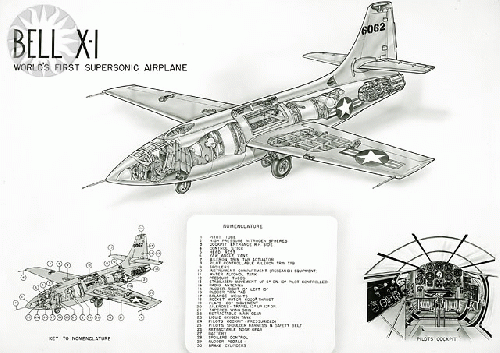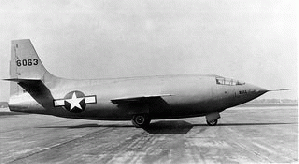>

A cutaway drawing of the venerable X-1 supersonic aircraft. Note that the entire horizontal stabilizer assembly moves.
(Image by Smithsonian Institute) Details DMCA

Jack L. Ridley, Aeronautical Engineer, Test Pilot, and Badass
(Image by (Not Known) Wikipedia, Author: Author Not Given) Details Source DMCA

The story you are about to read is true. The names have not been changed to protect the innocent...
Captain Chuck Yeager climbs into the X-1 aircraft for another flight test involving the sound barrier. After the traditional exchange of Beeman's gum, Major Jack Ridley helps to lower the hatch and lock it in place. The X-1 is attached to the belly of a converted B-29 bomber, which will soon be released so that Yeager can ignite his rocket engines from a safe distance. The two men hope to make history on this day in 1947.
The aircraft drops from the mothership, and the mighty X-1 is on its way. Yeager levels the beast out and attempts the record. Everything is going smooth. He has full 3D control of his airplane and all that's needed is a final push through the sound barrier.
Except that as his speed increases, the aircraft's pitch effectiveness diminishes and is eventually nullified altogether. At around 0.94 Mach, he can not move the yoke forward or back. He can roll left or right and yaw left or right, but he can not pull the nose up or push it down. Without pitch control, there will be no supersonic flight.
Ridley, expecting a successful supersonic flight, is incredulous as he hears Yeager announcing the bad news over the radio and watches him ease the rocket thrust back and eventually shuts it down. Yeager glides back to an uneventful landing.
History is not going to be made on this day after all.
After the X-1 is towed back to the flightline, Ridley and Yeager have a postflight discussion. Yeager describes in detail how all controls save pitch were effective throughout the flight. Roll is induced in an aircraft when the ailerons are moved up and down, but in opposite directions on each wing. Yaw is induced by moving the rudder on the vertical stabilizer left and right. Pitch is induced by moving the elevators up and down on the horizontal stabilizer. So why in the world would pitch be ineffective, but roll and yaw be uneffected?
It certainly looked like supersonic flight was indeed a physical impossibility...
::
The chase for the supersonic lifestyle was on for a long time. The British and the Soviets were in on it, and there was almost a race going on to see who would be the first to break the sound barrier. Almost.
The chase really began in earnest shortly after World War 2 ended. Propeller-driven fighters were put in a steep dive to try to break the speed of sound, but control of the aircraft was always lost right before ripping a hole in the air and, sometimes, in their aircraft.
It was quite a mystery. So much so that even the film industry got involved! One movie showed how the British solved the great supersonic mystery by applying reverse controls (yes, you read that right). If the pilot wants to pull the nose up while in supersonic flight, just push the control stick forward. Want to turn left? Act like you're turning right. Supersonic flight: doing things bass-ackwards and getting things done!
Of course, reversing controls would never work in any situation, especially if the control stick couldn't be budged forward and backward. The film industry may be fairly decent at telling a story, but they don't know diddly squat about aeronautical engineering. Of course, as it turns out, the Ph.D.s with their aeronautical engineering degrees were just as flummoxed as everybody else. Except for Major Jack Ridley, who had a Master's Degree in Aeronautical Engineering from the California Institute of Technology. He also understood a few things about stability and control in an aerodynamic environment. Which is to say, Jack Ridley was a badass. No wonder he was named Project Engineer for the X-1. While the Ph.D.s were trying to figure out what to do next, Ridley was doing some figuring on his own. And he came up with an idea...
::
After receiving his Bachelor of Science degree in Mechanical Engineering, Jack Ridley joined the Army and became an artillery officer. He didn't get bitten by the flying bug until later, and eventually earned his wings in 1942.
Ridley then began his second incarnation of his career, that of a military pilot, and eventually, military test pilot. He was assigned to flight testing duties during the war, simply because he was too talented (read: too badass) to be used in combat. After working on several projects, such as the B-24 and B-36, Ridley gets sent to Caltech to get his Master's. Eventually, he winds up with Chuck Yeager and the X-1 backup test pilot Bob Hoover in an attempt of the impossible. His job is to analyze the data brought back by each X-1 flight so that he can figure out a way to accomplish the impossible.
::
The X-1 was to be the answer to the problem of faster-than-sound flight. The engineers decided that a bullet-shaped vehicle would penetrate the shock wave that always forms at the nose of any airplane that attempts to go anywhere near the speed of sound. Besides, in the parlance of engineers, any airplane shaped like a bullet should be able to go faster than sound. The shock wave starts out as a vertical "wall", bending and enveloping and surrounding the airplane as it goes faster and faster. It was hoped that the X-1 would punch through the shockwave, and travel where no one had ever traveled before.
But after the X-1 flight team's latest report, the engineers were still perplexed.
Ridley was puzzled as well. And if Ridley was puzzled about something, it must be about something serious. Being the first to break the sound barrier would not only be historic, but would also give a competitive edge over the Air Force's main rival: the Soviet Union. Which about covers the idea of "something serious."
But it just didn't make any sense. Why would the shockwave only effect controls in one axis and not the other? And why that one particular axis? It was truly puzzling.
As Ridley and the other aeronautical brains pour over the data from Yeager's latest flight, the cause of the problem begins to sift to the top. It is discovered that the X-1 shockwave had bent so much as to actually meet at a point somewhere near the tail of the airplane. In fact, the shockwave was meeting at almost the exact location of the very hinges of the elevators. Thus the reason for the lack of effective pitch control: the shockwave is the culprit, in that it was clamping down on the elevator, and not even a Chuck Yeager could budge it, include the man himself. It would require superhuman strength.
The engineers are devastated. All of their calculations and models did not predict that the shockwave would be converging so close to the aircraft, let alone around the tail area. This means that the X-1 program is dead in the water, and the aircraft will have to be redesigned and re-flight tested, causing further delays in this supersonic race. The situation looks hopeless, and in need of a desperate solution.
Enter Superman, a.k.a. Major Jack Ridley.
Ridley understands the problem first hand, being the project engineer, and thinks that he has an idea. While the engineers all understand the problem like Ridley does, they don't understand the aircraft like Ridley does. And that's the edge that will make all the difference...
::
Most aircraft have a way to "trim" the flight path, which results in hands-off-flying; no control inputs are needed to maintain steady flight. For example, to trim the X-1 in the pitch axis, the horizontal stabilizer can be set while on the ground in a nose-up or nose-down attitude, depending on the Center-of-Gravity (CG) of the aircraft at the time of the flight. If the CG is a little forward, then set the horizontal stabilizer to a slight nose-up attitude to compensate. Then the aircraft can fly straight-and-level, hands-free. So what does all of this have to do with supersonic flight?
Ridley's idea is to use the pitch trim controls in a way that had never been used before, simply because there had never been a need to before. The pitch trim is set on the ground and the X-1 is then sent aloft. But what if the pitch trim acted as an elevator, where the entire horizontal stabilizer would be used to bring the nose up or down? That would mean that Yeager would have to fly the X-1 through the sound barrier normally in the roll and yaw axis, and use a switch to fly the pitch axis. Of course, the pitch trim mechanism wouldn't be as responsive as the yoke, but all Yeager needed to do was to get past Mach 1, then ease it back for a landing into history. The supersonic portion of the flight would only need to last long enough for the ground tracking equipment to verify their faster-than-sound speed.

A cutaway drawing of the venerable X-1 supersonic aircraft. Note that the entire horizontal stabilizer assembly moves.
(Image by Smithsonian Institute) Details DMCA
Ridley explains to Yeager the new flight profile, and with his cracked rib, a stick of Beeman's, and a sawed-off broom handle to assist in securing the hatch, Yeager flies the profile perfectly and earns his place in history.
Problem solved.
But what about Jack?
::
The superman who solved the supersonic problem went on to continue to be a badass, eventually becoming the chief of the prestigious Flight Test Engineering Laboratory at Edwards AFB. He standardized all data collection methods and set up a centralized Data Processing System to more efficiently handle flight testing interpretation. His techniques and philosophy are still used at Edwards today.
But the very same superman never became a household name, never became a celebrity, never got to write his autobiography, and never got to retire comfortably. In 1957, despite what is depicted in the movie "The Right Stuff," Colonel Jack L. Ridley, Aeronautical Engineer, died ingloriously at the age of 41 when the airplane he was a bleeping passenger in crashed into a mountain in Japan.
A true national treasure was lost on that day, and an engineer this brilliant in the real world, as well as the world of numbers and equations, only comes along once in a lifetime. Yeager correctly credits Ridley with the success of the X-1 program. It can be said that all supersonic supermen that fly military fighter jets owe their hair being on fire to an unassuming badass genius who used a concept totally unrelated to faster-than-sound travel to actually achieve faster-than-sound travel. Amazing.
Here's to you, Colonel Ridley; to the first Supersonic Superman.

Jack L. Ridley, Aeronautical Engineer, Test Pilot, and Badass
(Image by (Not Known) Wikipedia, Author: Author Not Given) Details Source DMCA
::
by Joe Maness and Richard Kerry Holtzin, Ph.D.
| Rate It | View Ratings |
Joe Maness is a High School Mathematics Teacher. He is writing a S.T.E.M. Lab textbook along with Dr. Holtzin.
The views expressed herein are the sole responsibility of the author
and do not necessarily reflect those of this website or its editors.

OpEdNews depends upon can't survive without your help.
If you value this article and the work of OpEdNews, please either Donate or Purchase a premium membership.
STAY IN THE KNOW
If you've enjoyed this, sign up for our daily or weekly newsletter to get lots of great progressive content.
If you've enjoyed this, sign up for our daily or weekly newsletter to get lots of great progressive content.
To View Comments or Join the Conversation:




